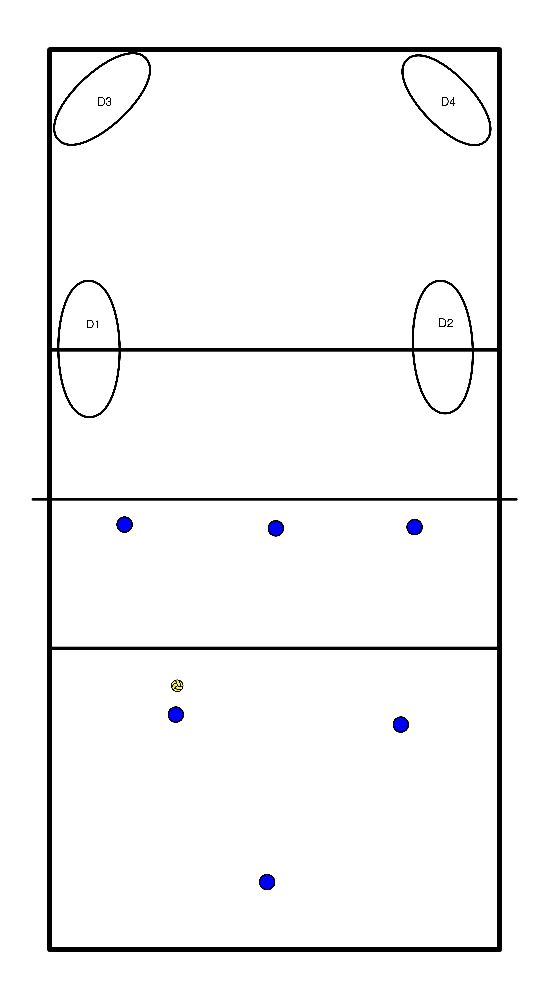Volleyball drills
- Bring your hands to the ground from an upright position and keep your legs stretched.
- Take small steps forward with your hands until you cannot go any further..
- Then move your feet towards your hands until you cannot go any further. Take small steps, only using your ankles to walk.
- Repeat these movements a number of times.

- When delivering a freeball we want to disrupt the opponents offence as much as possible.
- We can also use the freeball to take out an offensive attacker by pulling them close to the net or making them take the first contact.
- Dump zones are meant to target the setter or setter transition area and to pull an outside hitter off of their approach.
- If there is time, the player passing the ball should look at the opponents side of the net to determine where to place the ball - D1, D2, D3, D4
- Teammates not involved in the play should be:
- Ready to defend the freeball
- Looking at the opponents transition or positioning on the court
- Communicating to the player passing the ball on where to put the ball - 1, 2, 3, 4

- Holding a plate with your hands at the 9 and 3 positions, this exercise builds the core and also develops upper body strength.
- Specific to volleyball, it helps the shoulder stay healthy and aids in the transfer of power from the core to the upper body.
- This exercise, done with 2 dumbbells, is good for glute strength, hamstrings and improving an athlete's vertical jump.
- Some volleyball players choose to do stationary mat twist exercise for improving core rotational speed.
- Keep in mind that you need to prepare a mat as well as weight (or a medicine ball) for this exercise.
- First of all, you should kneel on a mat and hold a weight (or a medicine ball). Now, your job is to rotate to the right and then return to the center.
- You also need to rotate to the left and then return back to the center.
- It’s another exercise that helps volleyball players develop foot speed.
- Uphill acceleration sprints involve sprinting on an uphill incline.
- You should perform sprints for a certain distance a set number of times.
- It’s a good idea to experiment with sprints.
- Set a number of repetitions, distance as well as the duration of break for sprints.
- Doing exercises like colored cones circles helps improve foot speed that’s incredibly important for a volleyball player.
- First of all, you should prepare randomly colored cones.
- You should also ask a coach (or friend) to assist you with this exercise.
- At the next stage, you need to place colored cones in the circle.
- Your goal is to create a circle that is 20 feet wide.
- Now, you need to stand in the center of the circle.
- The job of a coach (or friend) is to pick one of colored cones for you.
- So, you will need to approach to the appropriate cone as soon as possible and then return back to the circle’s center using a crossover step.
- It’s fair to say that volleyball is a very fast game.
- That means that a volleyball player should be able to move quickly to do great job on the court.
- Volleyball players should focus on increasing foot speed as well as core rotational speed.
- Now, it’s time for you to get familiar with some of the best volleyball exercises for explosive speed.
- Volleyball players should do high knee skips for a number of reasons.
- It’s important to know that doing this type of exercise has a positive impact on a volleyball player’s calves, hamstrings and hip flexors.
- If you do this type of exercise regularly then you will be able to improve your vertical jump, endurance and coordination over time.
- Oftentimes, a volleyball player needs to jump off one leg during the game.
- It’s worth noting that this type of jumping is done by both attackers and defensive volleyball players.
- That’s the reason why athletes should do single leg bound exercise regularly.
- Actually, this volleyball exercise has many great benefits.
- First and foremost, doing single leg bound helps volleyball players succeed in jumping off one leg.
- On the other hand, this exercise helps a volleyball player gain the confidence that he/she needs to do this type of jumping.
- The exercise also positively affects a volleyball player’s hip as well as hip flexor and quads.
- It’s crucial for volleyball players to do single leg bound exercise the right way.
- When jumping off one leg you should try to keep your opposite knee up as high as it’s possible.
- Doing squat jumps helps volleyball players strengthen calves, glutes, hips as well as quads.
- When squatting down volleyball players should try to keep hips parallel.
- Make sure that your knees are bent at 90 degrees.
- Doing tuck jump has a profound positive impact on a volleyball player’s glutes, hips and quads.
- When doing this type of volleyball exercise you should keep your knees as high as possible.
- Plus, you need to spend as little time on the ground.







